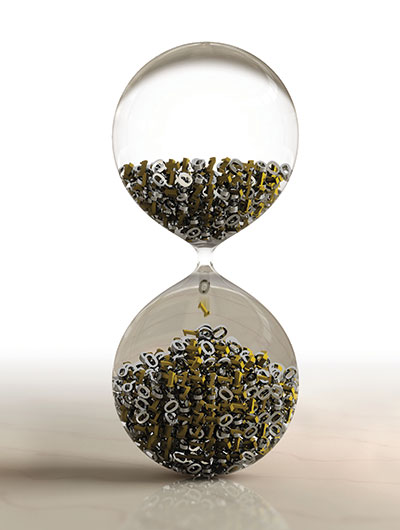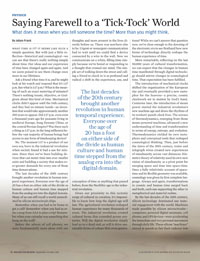In Review
 (Photo: Steve Boerner for Rochester Review)
(Photo: Steve Boerner for Rochester Review)What time is it? It seems like such a simple question. But with just a little reflection—historical and cosmological—we can see that there’s really nothing simple about time. Our ideas and our experience of time have changed again and again. And we seem poised to see them change once more in our lifetimes.
Ask a friend what time it is, and he might look at his watch and respond that it’s 1:17 p.m. But what is 1:17 p.m.? What is the meaning of such an exact metering of minutes? There’s nothing innate, objective, or God-given about this kind of time. Mechanical clocks didn’t appear until the 14th century, and they had no minute hands—an invention that would take approximately another 300 years to appear. Did 1:17 p.m. even exist a thousand years ago for peasants living in medieval Europe, Song Dynasty China, or the central Persian Empire? Was there such a thing as 1:17 p.m. in the long millennia before the vast majority of human beings had access to any form of timekeeping device?
No. The moment 1:17 is a product of our own era, born in the industrial revolution when society found it had a use for minutes. Since then we’ve been building devices that can meter time into ever smaller units and building a society that makes ever-greater demands for every one of those time demarcations.
The last decades of the 20th century brought another revolution in human temporal experience. Everyone over the age of 20 has a foot on either side of the divide as human culture and human time stepped from the analog era into the digital domain. Many of us can still recall a world unmediated by silicon microcircuit chips.
Remember when you had to be home to get a call?
Remember when you had to order a map from AAA to plan a trip?
Remember when your calendar was something that hung on the wall?
Before the advent of cell phones, we were fundamentally more alone with our thoughts and more present in the lives directly before us. There was nowhere else to be. Urgent or nonurgent communication had to wait until we could find a device connected by a wire to the wall. Now we communicate on a whim, filling time simply because we’re bored or responding to a thought that crossed our mind. The simple act of walking down the street and calling a friend to check in is as profound and radical a shift in the experience, use, and conception of time as anything that passed before, from the Neolithic age to the industrial revolution.
Given our proximity to this tectonic surge of cultural re-creation, it’s impossible to know how long the digital age will last. The agricultural revolution reshaped human experience for many thousands of years. The industrial revolution created cultural forms that extended across centuries. Will the digital revolution simply lead us to a dead end, or will it drive sustainable forms of culture that cross generations? While we can’t answer that question now, we’re close enough to the dawning of the electronic era to see firsthand how new forms of technology directly reshape the human experience of time.
More remarkably, reflecting on the last 50,000 years of cultural transformation, we can expect that the changes in human time manifested through digital technology should mirror changes in cosmological time. That expectation has been fulfilled.
The introduction of mechanical clocks shifted the organization of the European day and eventually provided a new metaphor for the heavens—a precise, cosmic clockwork set in motion by God’s hand. Centuries later, the introduction of steam power started the industrial revolution’s new machine age and drove the rhythms of its workers’ punch-clock lives. The science of thermodynamics, emerging from those steam-powered machines, advanced a new understanding of time and transformation in terms of energy, entropy, and evolution. Thermodynamics yielded its own metaphors and conceptual tools that reshaped cosmological thinking. Then, just before the dawn of the 20th century, trains and telegraph wires created new experiences of simultaneity across vast distances. Einstein’s theory of relativity used its own new vision of simultaneity as a pivot point for merging space and time into space-time. Once a fully relativistic account of space-time and its flexible geometry was available, cosmology was given its first complete language. Always and again, transformations in cosmic and human time surged back and forth, each one supporting the other in metaphorical and material realms.
By the last decades of the 20th century, silicon technology dominated our material engagement with the world. Machines made possible by silicon microcircuits—computers, personal digital assistants, cell phones, and GPS devices—were accelerating the immediate and very personal movement through daily life. These silicon “machines” moved at speeds so fast their cadence was far more native to atoms than to humans. By building culture timed to their clock cycles, we’ve compressed our own time and experience in ways both thrilling and exhausting. In our working and personal lives we’re expected to do more because these machines make it possible. And so we’ve entered a new time whose contours are as closely felt and intimately lived as the tick-tock world of our great-grandparents or the sun-parsed days of our distant ancestors.
At the same time, the scientific capacities unleashed in the computer age pushed our cosmic narrative of the Big Bang to its limits. Computer simulations, massive data-gathering projects, and space-based telescope platforms revealed new challenges to any cosmology that would begin with a beginning. In the closing years of the last century, the pace of life, time, and cosmic evolution all were set in a permanent state of acceleration.
Now with astronomers recognizing the reality that the entire universe is accelerating—expanding at ever faster rates as cosmic time moves forward—they are left trying to imagine new possibilities for cosmic origins. Was there really a Big Bang, or has the universe been moving through cycles of birth and death forever? Is there just one universe or does an infinite number of universes—a multiverse—exist, each perhaps with its own laws of physics?
Thus cosmic time and human time are set to change together once again, as they have so many times in the past. The stage is set, and we can only watch in wonder as the drama of human and cosmic time enter their next act.
Adam Frank, a professor of astrophysics, is the author of About Time: Cosmology and Culture at the Twilight of the Big Bang (Simon and Schuster, 2011), from which he adapted this essay. Frank is also a regular contributor to 13.7: Cosmos and Culture (www.npr.org/blogs/13.7), a website of NPR that explores the connections between science and culture.

